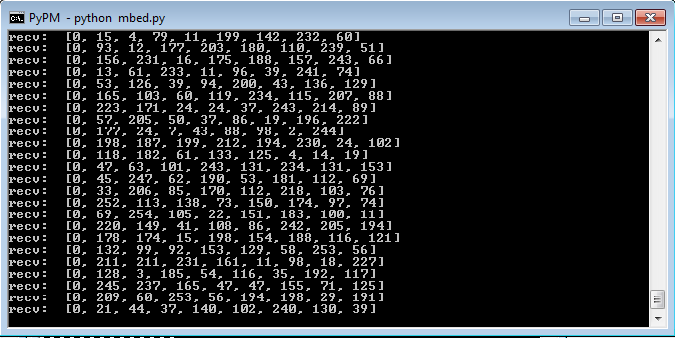You are viewing an older revision! See the latest version
USBHID bindings
Purpose of this webpage
The purpose of this webpage is to develop programs:
- which are able to send and read raw data from an mbed HID device.
- in different programming languages
- running on different platforms
USBHID bindings status¶
| Language | Windows | Linux | Mac OS |
|---|---|---|---|
| Python | Yes | ||
| C | |||
| C++ | |||
| Java | |||
| Others |
Mbed test case code¶
On the mbed, we want to test that we are able to:
- send raw data
- receive raw data
For this a simple program has been developed:
#include "mbed.h"
#include "USBHID.h"
//We declare a USBHID device. Input out output reports have a length of 8 bytes
USBHID hid(8, 8);
//This report will contain data to be sent
HID_REPORT send_report;
HID_REPORT recv_report;
Serial pc(USBTX, USBRX);
int main(void) {
send_report.length = 8;
while (1) {
//Fill the report
for (int i = 0; i < send_report.length; i++) {
send_report.data[i] = rand() & 0xff;
}
//Send the report
hid.send(&send_report);
//try to read a msg
if(hid.readNB(&recv_report)) {
pc.printf("recv: ");
for(int i = 0; i < recv_report.length; i++) {
pc.printf("%d ", recv_report.data[i]);
}
pc.printf("\r\n");
}
wait(0.1);
}
}
Import programUSBHID_TestCase
USBHID test case
Computer side program¶
To validate the test case and write a Yes in the USBHID bindings status ;), a program has to prove that it is able to:
- Read data from the mbed
- Send data to the mbed
Example in Python on Windows¶
On Windows I use pywinusb to communicate with the mbed
Code¶
#
#Simple example on how to send and receive data to the Mbed over USB (on windows) using pywinusb
#
import pywinusb.hid as hid
from time import sleep
import random
# handler called when a report is received
def rx_handler(data):
print 'recv: ', data
def findHIDDevice(mbed_usage, mbed_vendor_id):
# Find all devices connected
all_devices = hid.HidDeviceFilter(vendor_id = mbed_vendor_id).get_devices()
if not all_devices:
print "No device connected"
else:
# search for the Mbed
for HIDdevice in all_devices:
try:
HIDdevice.open()
# browse output reports
for report in HIDdevice.find_output_reports():
if mbed_usage in report:
#MBED found
print 'Mbed detected'
#Attach a custom handler when a data is received
HIDdevice.set_raw_data_handler(rx_handler)
#send a report each 0.2 second. The report is a random array of 8 bytes
while True:
for i in range(8):
report[mbed_usage][i] = random.randint(0, 255)
report.send()
sleep(0.2)
except:
print 'close'
HIDdevice.close()
if __name__ == '__main__':
# The vendor ID used in the Mbed program
mbed_vendor_id = 0x1234
# Vendor page and usage_id = 2
mbed_usage = hid.get_full_usage_id(0xffab, 0x02)
# Search the Mbed, attach rx handler and send data
findHIDDevice(mbed_usage, mbed_vendor_id)
Demo¶


- On the left screenshot, we can see data received by the mbed: a random array containing 8 values as expected.
- On the right screenshot, we can see values sent by the mbed to the python script. The last 8 values printed are random values sent by the mbed. The first byte represents the report_id. As there is not report_id for this USB device, by default, there is 0.
Conclusion¶
An example using python has been developed to communicate with the mbed but it would be great to develop a lot of programs in C, C++, Java, Haskell, Scala, Factor, ... having the same capabilities.
Feel free to contribute to this webpage by developing programs able to communicate with your mbed. You can use your own protocol on top of the USBHID layer to design your own USB device!
